
Beekeeping Calendar
To keep track of hive activity, here is a list of activities taking place each month. There are also suggestions of activities the beekeeper should perform, along with an approximate timeframe to be spent with your bees each month.
January
The bees. Thousands of workers huddle around the queen bee amidst their winter cluster. Little activity occurs, with the exception of cleansing flights on warm days (around 50°F.) In the absence of drones, a few worker broods will appear in the hive. The bees will take in around 25 pounds of honey during this month.
The beekeeper. Minimal work from you will be necessary at the hives. When heavy snow accumulates, be sure to clear the hive entrance in order to provide ventilation. Use this month to conduct further research on bees, partake in bee club meetings, and prepare next season’s equipment. Be sure to contact a credible supplier and order packaged bees, if necessary.
Time spent: Less than an hour.
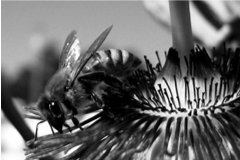
Provided by Amy Grisak
February
The bees. While comfy in the cluster, the queen bee will start laying a few more eggs per day. Though only females are permitted in the hive, worker bees will start taking cleansing flights on warmer days. Again, the bees consume 25 pounds of honey this month.
The beekeeper. Like January, there is not much for you to do aside from attending bee club meetings and reading up on your bees. It is wise to prepare your spring equipment, too.
Time spent: Less than an hour.
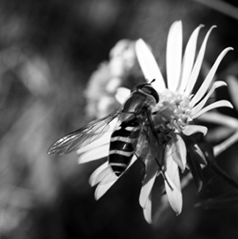
March
The bees. During this month, there is a risk of colonies dying off due to starvation. This can be prevented by giving the bees a lot of sugar syrup during the fall. As the length of days increases, the queen gradually increases the number of eggs she lays. With more brood, the drones start to show up, and a larger amount of food is taken in by the bees. Honey stores are still consumed by the bees.
The beekeeper. On a nice, warm day, take a glance into the hive. Without removing the frames, glance under the cover. Emergency feeding may be required if no sealed honey appears in the top frames. Continue the feeding until the bees are gathering their own food supplies. At this time, be sure to add Apistan® strips (leave in the hive for 45 days).
Time spent: 2 hours.
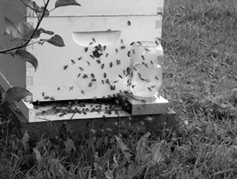
Provided by Amy Grisak
April
The bees. As the weather improves, early blossoms start to surface. As bees are bringing pollen in, the queen is occupied in the hive laying eggs, causing the population to grow rapidly. The drones start to show up, as well.
The beekeeper. Conduct a thorough inspection on the first warm, calm day. Can you spot the queen along with eggs and brood? Is there a nice egg-laying pattern? During the later period of the month, you may want to reverse the hive deeps. The broods will be adequately distributed, and the growth of the colony will be positively impacted. Start feeding the hive with a mix of medicated syrup and menthol, which serves as mite control.
Time spent: 3 hours.
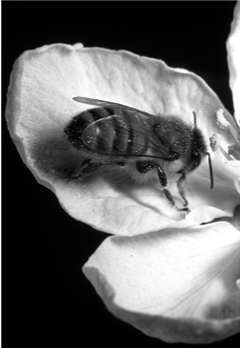
Provided by the USDA
May
The bees. Activity increases this month as nectar and pollen is coming into the hive thickly and quickly. With the queen’s achieving her highest rate of egg laying, the hive will be bustling with activity.
The beekeeper. Apistan strips may be removed, if they have been present in the hive for 45 days. Menthol also needs to be taken away. Add on a queen excluder, putting honey supers at the top of the top deep. Beware of swarming, and examine the hive on a weekly basis. Continue to partake in bee club meetings and workshops.
Time spent: 4-5 hours.
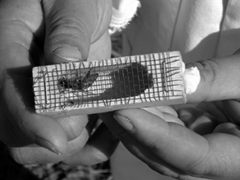
Provided by Amy Grisak
June
The bees. Although the queen’s rate of laying eggs may decrease a bit this month, the unswarmed colonies will be filled with bees. The primary flow of honey will occur.
The beekeeper. Examine the hive on a weekly basis to ensure that it is healthy and that the queen is there. Continue to add on honey supers and inspect swarms. Again, participate in bee club meetings and workshops.
Time spent: 4-5 hours.
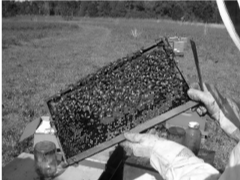
Provided by FDACS-DPI (University of Florida)
July
The bees. Weather permitting, the flow of nectar may continue. On hot nights, bees may be seen trying to cool off on the hive’s exterior.
The beekeeper. Ensure the health of your colony by adding additional honey supers, if needed, and conducting regular inspections.
Time spent: 2-3 hours.
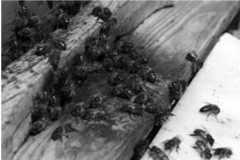
August
The bees. With the decrease in nectar flow, the growth of the colony is deterred. Nevertheless, drones are still around the hive.
The beekeeper. Relax, because there is not much for you to do this month. There is no chance for swarming. Keep an eye out for honey robbing by other bees.
Time spent: About 1-2 hours.
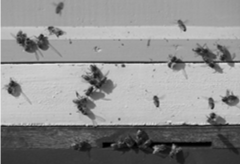
September
The bees. This month, a decrease in hive population and the queen’s egg laying is evident. Drones may start to vanish.
The beekeeper. While harvesting the honey crop, do not forget to allot 60 pounds of honey for the colony to use during the winter. Be sure the queen is present, and feed and medicate once the end of the month is near (only medicate the first 2 gallons). Apistan strips need to be added and remain in the hive for 42 days. Additionally, menthol should be applied for mite control. Do not stop feeding the bees until they will take in no more syrup. Participate in bee club meetings.
Time spent: 2-3 hours.
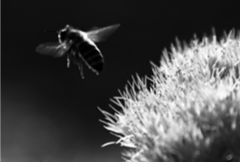
October
The bees. Preparing for the winter, the bees do not show much activity.
The beekeeper. Beware of robbing. To provide ventilation for the bees, put inner cover wedges in the hive. Place a mouse guard at the hive’s entrance. To ensure the colony remains dry, install Insulite® boards underneath the cover of the hive. A wind break may be constructed if needed. As you complete winter feeding, be sure to discard the Apistan strips. Again, take part in bee club meetings.
Time spent: 2 hours.
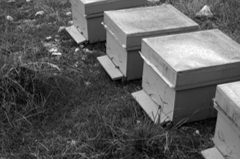
November
The bees. Activity decreases even more this month. The cold weather has the hive huddling up.
The beekeeper. Put your equipment away during the winter. Attend bee club meetings.
Time spent: About an hour.
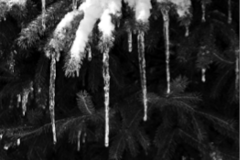
December
The bees. The bees are tightly compacted together.
The beekeeper. Enjoy your time off, because there is nothing to do with the bees this month. Curl up with a good book about beekeeping, or attend a beekeeping club meeting.
Time spent: None.
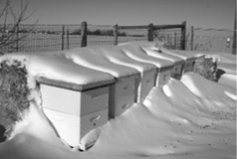
Provided by Amy Grisak